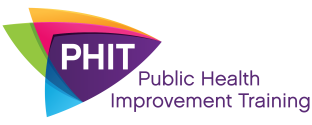Public Health Improvement Training Reaction Survey
Generic Clearance for the Collection of Qualitative Feedback on Agency Service Delivery
Attachment C - PHIT- End of Training Survey Instrument 5.8
Public Health Improvement Training Reaction Survey
OMB: 0920-1050


Form Approved
OMB No. 0920-1050
Expiration Date: 5/31/2022
Public Health Improvement Training (PHIT)
End-of-Training Evaluation
Introduction
Thank you for attending PHIT! Your feedback will help us improve future conferences. This survey should take no longer than 4 minutes. Responses will remain anonymous and be kept secure. If you have any questions or technical difficulties, please reach out to Nicole Waller at [email protected].
The public reporting burden of this collection of information is estimated to average 4 minutes per response, including time for reviewing instructions, searching existing data sources, gathering and maintaining the data needed, and completing and reviewing the collection of information. An agency may not conduct or sponsor, and a person is not required to respond to a collection of information unless it displays a currently valid OMB control number. Send comments regarding this burden estimate or any other aspect of this collection of information, including suggestions for reducing this burden to CDC/ATSDR Reports Clearance Officer; 1600 Clifton Road NE, MS D-74, Atlanta, Georgia 30333 ATTN: PRA (0920-1050)
Survey Questions
Which of the following statements, if any, are true about the conference logistics? (Select all that apply.)
|
|
|
|
|
|
|
Did you use the PHIT mobile app?
a. Yes (Skip pattern: If YES, display #2a)
b. No (Skip pattern: If NO, display #2b)
2a. Which of the following statements, if any, are true about your experience with the PHIT mobile app? (Select all that apply.)
|
|
|
|
|
|
2b. What, if anything, prevented you from using the PHIT mobile app?
______________________________________________________________________________________________________________________________________________________________________
Did you complete any part of the My PHIT Action Plan template?
Yes (Skip pattern: If YES, display #3a)
No
3a. In what way(s), if any, was the My PHIT Action Plan template helpful? (Select all that apply.)
|
|
|
|
|
|
|
3b. In what other way(s) did you find the My PHIT Action Plan template helpful?
______________________________________________________________________________________________________________________________________________________________________
Which of the following statements, if any, are true about your peer interaction at PHIT? (Select all that apply.)
|
|
|
|
|
|
|
|
4a. In what other way(s) did you experience meaningful peer interaction?
______________________________________________________________________________________________________________________________________________________________________
Which of the following statements, if any, are true about the training you received at PHIT? (Select all that apply.)
|
|
|
|
|
|
Consider the topics of greatest interest to you. Was there enough time devoted to these topics at PHIT?
a. Yes
b. No (Skip pattern: If NO, display #6a)
6a. Which topic(s) deserved more time?
______________________________________________________________________________________________________________________________________________________________________
Questions 7–9 will help us understand your perception of the overall value of your attendance at PHIT.
Overall, to what extent did you gain new skills that you can use in your work? (Select the one best option.)
|
|
|
|
Overall, to what extent was PHIT 2019 a valuable use of your time?
|
|
|
Please describe your PHIT experience in three sentences or less.
______________________________________________________________________________________________________________________________________________________________________________________________________________________________________________________
Questions 10–13 will tell us about you so that we can use your feedback in more specific ways.
Are you a member of the Public Health Performance Improvement Network (phPIN)?
Yes
No
I’m not sure
Are you a 2019 Strategic Scholar?
Yes
No
I’m not sure
What type of organization do you represent? (Select the one best option.)
Local health department
State health department
Territorial health department
Tribal health department or organization
Board of health
Academic institution, public health institute, or training center
State or regional public health association
National organization
Federal government agency
Other (Please specify) ______________________________
Which of the following best describes your position within your organization? (Select the one best option.)
Front-Line Staff (non-managerial) [Hover text: Public health professionals who carry out the day-to-day tasks of public health organizations and are not in management positions. Responsibilities of these professionals may include data collection and analysis, fieldwork, program planning, outreach, communications, customer service, and program support.]
Program Manager or Supervisor [Hover text: Public health professionals in program management or supervisory roles. Responsibilities of these professionals may include developing, implementing, and evaluating programs; supervising staff; establishing and maintaining community partnerships; managing timelines and work plans; making policy recommendations; and providing technical expertise.]
Senior Manager or Executive [Hover text: Public health professionals at a senior management level and leaders of public health organizations. These professionals may be responsible for overseeing major programs or operations of the organization, setting a strategy and vision for the organization, creating a culture of quality within the organization, and working with the community to improve health.]
Please provide any additional comments or suggestions to improve PHIT.
_________________________________________________________________________________________________________________________________________________________________________________________________________________________________________________________
Thank you for your feedback!
| File Type | application/vnd.openxmlformats-officedocument.wordprocessingml.document |
| Author | Brittany Bickford |
| File Modified | 0000-00-00 |
| File Created | 2021-01-16 |
© 2025 OMB.report | Privacy Policy